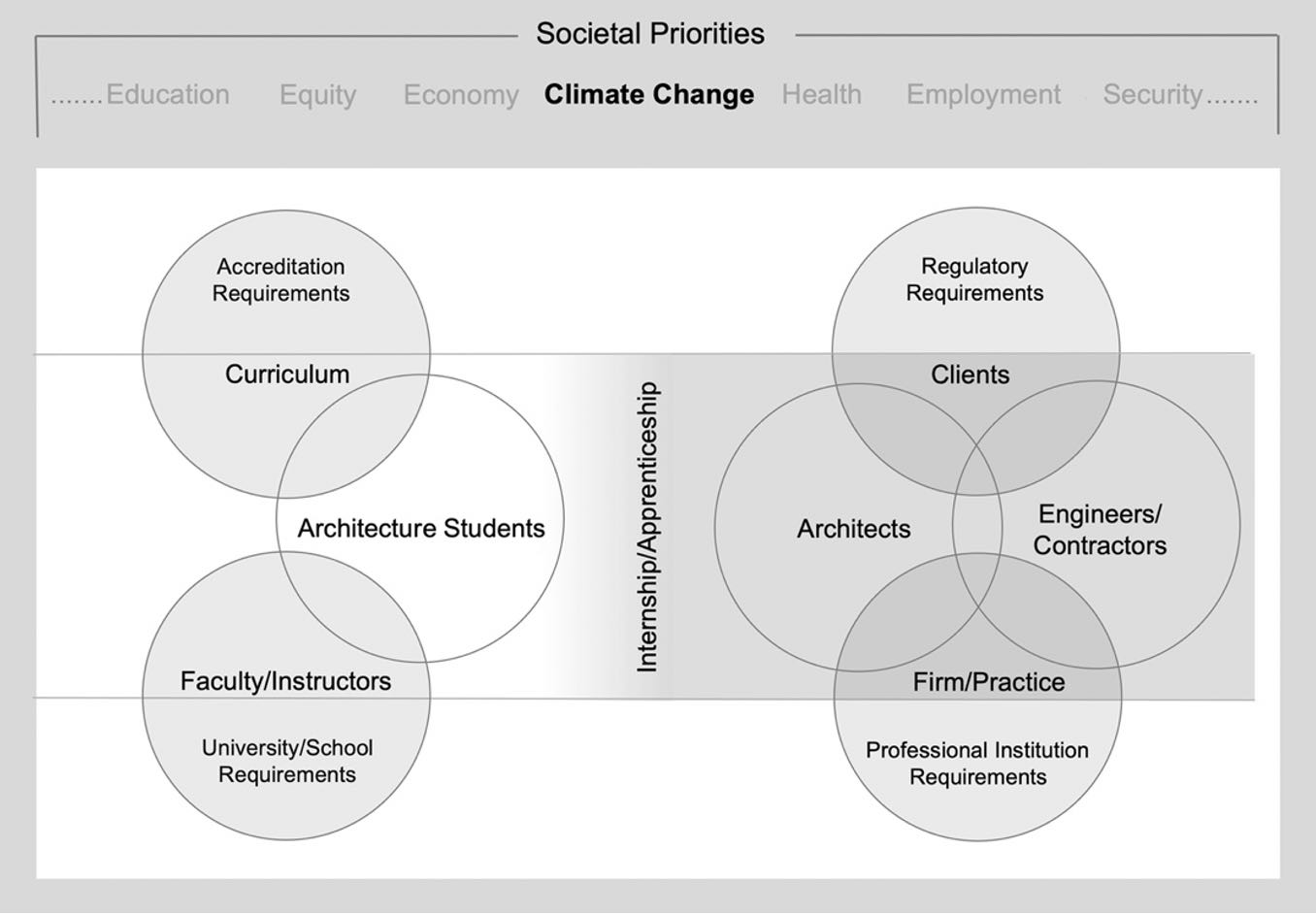
www.buildingsandcities.org/insights/commentaries/mainstreaming-architectural-education.html
Mainstreaming Carbon Zero in Architectural Education: Within a Decade?

Carbon literacy and carbon neutral design in higher education are part of a larger package of needed measures.
Raymond J Cole responds to the B&C special issue EDUCATION AND TRAINING: MAINSTREAMING ZERO CARBON. The ambitious timeframe for changing the core competences of architectural graduates may not fully impact on the profession by 2030, but nonetheless needs urgent change now. The transition to a zero carbon or net positive built environment will require changes in the educational curriculum and pedaogogy, new standards for course accreditation and clarity on what levels of knowledge and competences students must have. Other measures include: changes to licensure, support and training given to early career architects and a broader approach to design that also includes adaptation and the consideration of inhabitants' agency.
The urgency resulting from society's past collective inaction to address climate change now requires us to both make greater leaps in our efforts and make them in an even shorter time frame. Climate science has provided unequivocal evidence regarding the need to make significant global greenhouse gas (GHG) emissions reductions by 2030 and achieve carbon neutrality by 2050. Although there are a number of as yet unknown factors that will influence future societal actions and the rate at which they unfold, designing buildings that function within a carbon-constrained world is increasingly likely to dominate the future work of design professionals either through their proactive efforts, shifting client expectations, or more stringent regulations. However, the guest editors of B&C's timely Special Issue -- Education and Training: Mainstreaming Zero Carbon -- argue that the building industry 'currently lacks the appropriate low-carbon and knowledge skills at national and global levels' and, equally worrying, that '[i]nstitutional, industry and organisational responses' (Stevenson and Kwok, 2020) have failed to adequately provide them. As such, how can politicians be confident to enshrine legislation and regulations demanding carbon reduction targets for the built environment if the workforce is incapable of meeting them?
If the necessary competence of architects, engineers and various construction trades are to be significantly increased to meet the challenge of climate change, then we have to understand what competences are required and what improvements are realistically possible within the rapidly closing period of time available to avert climate catastrophes. The Special Issue focuses on educational institutions' current lack in their preparing the next generation of design professionals to engage the climate crisis and identify approaches 'to rapidly mainstream zero-carbon approaches in initial education as a crucial first step'. History would suggest that fundamental shifts have not been readily or quickly assimilated within the design and production of buildings or the scope and emphasis of architectural education. However, COVID-19 restrictions requiring universities and colleges to shift to virtual instruction has illustrated that massive changes are possible within a short period of time. Given that climate change is now recognized as the 'defining issue of our time,' that we are at a 'defining moment,' (United Nations, n.d.) and that the generations now entering school will be amoung the most affected, we should equally expect a timely engagement and integration of carbon literacy in teaching programs. Indeed schools arguably have an obligation to provide the necessary capabilities that will serve them in their future careers to engage the climate crisis.
Studying architecture in school is clearly different from working in professional practice, and what constitutes a demonstration of competence is not the same in these two stages in the development of an architect. A professional architectural education covers a broad range of considerations and accreditation requirements declare what knowledge and competences are to be attained by all students by graduation. But how such requirements are embedded in a school's curriculum is largely an internal matter and schools will defend the right to provide their students with an understanding of what they consider constitutes architecture as a distinct discipline. Although this typically derives from the faculty's reading of emerging issues and students' desire to acquire abilities which are expected by future employers, strengthening the accreditation criteria related to carbon literacy and requiring a meaningful demonstration of abilities would nonetheless influence educational priorities and accelerate change.
All students typically take
a series of technical courses as part of this broader architectural education
and low energy/carbon strategies typically fall with the scope of those teaching
environmental systems and controls.
However, this alone does not ensure the
application and integration of carbon literacy into design for two reasons. First, while it is possible to expose students
to various issues and ideas, these will not enter their decision-making unless
they are strongly committed and take ownership of them. Second, carbon
literacy must be reinforced in many other aspects of the curriculum and, in
particular, will gain prominence if students are encouraged
by studio instructors to explore ways to integrate newly acquired technical and
other related knowledge into design. 
Although school and the profession are distinct, the transition from one to the other is an important stage (Figure 1). Graduates wishing to practice architecture are immediately faced with the task of finding an opening in an office -- ideally one whose approach is consistent with their own interests and priorities. Importantly, in school, students are learning 'design', grappling with a broad range of considerations and synthesising newly acquired knowledge, and their proposals are seldom subject to the litmus tests and rigorous scrutiny of cost, regulation, practicality and reconciling competing priorities of different stakeholders. Depending on their workplace experience acquired either prior to or during their architectural studies, it is not unusual that recent graduates are considered insufficiently prepared by their employers to seamlessly enter professional practice, or for they themselves to feel insufficiently ready after their education.
Licensure examinations provide another point at which to further test competence. If carbon reductions are a societal goal and a professional obligation, then its explicit inclusion as a mandatory requirement for licensure would send a strong message both to education and to professionals to reinforce the importance of climate literacy. This could have a likely further effect of raising the standards for course accreditation and, moreover, have a positive impact on students at a formative stage allowing them to integrate the values, skills and competences.
The Special Issue identifies several characteristics of professional practice relevant to reframing carbon neutrality in educational programs. First, although architects may hold a personal conviction that motivates them to reduce carbon emissions in their projects, they are, to a large extent, at the service of clients and hampered by others who may not hold the same conviction. Second, stakeholders associated with the production of buildings have different expectations and priorities, and those holding greater control over decision-making and resources typically dictate outcomes. Third, prioritisation of zero carbon depends not only upon the commitment and expertise of built-environment professionals, but also on the willingness of others to be so convinced. As such, the 'real imperative lies with the need for continuous learning across professional boundaries'(Green and Sergeeva, 2020) and to persuade others.
Should every architectural student acquire carbon neutral design competences by the time they graduate? While this to some extent depends on their career path, it is useful to distinguish between two necessary competences. The first includes deliberately questioning the assumptions one holds and openness to reframing problems, teamworking, collaborating and sharing ownership of ideas with others (Killip, 2020; Clarke et al., 2020). These are individual and equally applicable to addressing other complex societal issues and clearly should be instilled in every student. The second capabilities relate to the knowledge and skills on how to design buildings with significantly reduced carbon reductions and ability to demonstrate those reductions. While in professional practice such competencies and capabilities typically reside within a design team, at a minimum it is important that every architecture graduate understands why this is necessary and are sufficiently carbon literate to participate meaningfully in team meetings. Srivastava's (2020) innovative studio pedagogy shifts from individual ownership of work and towards groupings of works and students, where 're-assigned ownership [is] based on interest, self-identified strengths (skills they can contribute or teach), or deficits (skills they need to learn), rather than authorship.' If architectural education shifts to greater group/teamwork where students can bring different compencies to a carbon neutral design, all team-members can legitimately claim ownership of the completed project even though all did not have or provide the necessary technical skills to the process.
Over time, a critical mass of younger architects entering the profession with the competences and beliefs pertaining to carbon reduction have the power to create change within firms, particularly in smaller/middle-sized ones where their voice can challenge and positively influence attitudes and practices. The US National Council of Architectural Registration Boards' (NCARB, 2019) report shows that there were 115,000 licensed US architectural practitioners in 2018 and that approximately 6000 architectural students graduated from accredited US architectural schools that year. As such, approximately 5% of new graduates potentially enter the profession annually. In the UK, the Royal Institute of British Architects (RIBA) identify equivalent numbers in 2018: approximately 54,000 registered architects (Statista, n.d.) and 2032 architectural graduates (Mirza and Nacey Research, 2020) -- approximately 3.8% of the total workforce. In both cases, a number of years will pass before graduates gain sufficient office experience and take the exams necessary to become a licensed architect, and not all graduates enter the architectural profession but choose alternative career paths. Are the contributions that graduates can make before 2030 likely to create a necessary and timely increase in 'capabilities (knowledge and skills) and competencies to rapidly decarbonise built environments and reduce environmental degradation for both new construction and the existing building stock' (Stevenson and Kwok, 2020)? Probably not -- but this does not diminish the necessity to produce a generation of carbon literate graduates from architectural and other professional and vocational programs. Indeed, it probably represents a faster change than the equally necessary upskilling of practitioners through the implementation of continuing professional development programmes.
Given that there is a high probability that the reductions in greenhouse gas emissions will be insufficient, we will be navigating through a difficult, turbulent period for the foreseeable future and there is a need to help people prepare for and engage a changing world. As a necessary complement to mitigation, it would be prudent to ensure that the built environment is infused with the capability to enable inhabitants' greater agency to adapt to the consequences of increasingly uncertain weather systems.This would shift architecture schools' current new building focus to existing ones and how new buildings can play a connective and weaving role of the urban fabric. Moreover, positioning buildings as nodes within systems rather than stand-alone entities suggests that the goal of carbon neutrality may be most appropriate at neighbourhood or larger scale and that, while the carbon emissions associated with the production and operation of all buildings must be significantly reduced, every building need not be expected to have the same carbon footprint.
References
Clarke, L., Sahin-Dikmen, M. and Winch, C. (2020). Transforming vocational education and training for nearly zero-energy building. Buildings and Cities, 1(1), pp. 650-661. DOI: https://doi.org/10.5334/bc.56
Green, S. D., & Sergeeva, N. (2020). The contested privileging of zero carbon: plausibility, persuasiveness and professionalism. Buildings and Cities, 1(1), pp. 491-503. p. 494. DOI: https://doi.org/10.5334/bc.49
Killip, G. (2020). A reform agenda for UK construction education and practice. Buildings and Cities, 1(1), pp. 525-537. DOI: https://doi.org/10.5334/bc.43
Mirza and Nacey Research (2020). RIBA Education Statistics 2018/19. https://www.architecture.com/-/media/DE213D6DC130456CA4643B01890A8D73.pdf?la=en
National Council of Architectural Registration Boards (NCARB) (2019). Education Report. https://www.ncarb.org/nbtn2019/education
Srivastava, M. (2020). Cooperative learning in design studios: a pedagogy for net-positive performance. Buildings and Cities, 1(1), pp. 594-609. DOI: https://doi.org/10.5334/bc.45
Statista (n.d.). Total number of architects in the United Kingdom (UK) from 2011 to 2020.
Stevenson, F., & Kwok, A. (2020). Mainstreaming zero carbon: lessons for built-environment education and training. Buildings and Cities, 1(1), pp. 687-696., p. 687. DOI: https://doi.org/10.5334/bc.84
United Nations (n.d.). Climate change. https://www.un.org/en/sections/issues-depth/climate-change/
Latest Peer-Reviewed Journal Content
A framework for 1.5°C-aligned GHG budgets in architecture
G Betti, I Spaar, D Bachmann, A Jerosch-Herold, E Kühner, R Yang, K Avhad & S Sinning
Net zero retrofit of the building stock [editorial]
D Godoy-Shimizu & P Steadman
Co-learning in living labs: nurturing civic agency and resilience
A Belfield
The importance of multi-roles and code-switching in living labs
H Noller & A Tarik
Researchers’ shifting roles in living labs for knowledge co-production
C-C Dobre & G Faldi
Increasing civic resilience in urban living labs: city authorities’ roles
E Alatalo, M Laine & M Kyrönviita
Co-curation as civic practice in community engagement
Z Li, M Sunikka-Blank, R Purohit & F Samuel
Preserving buildings: emission reductions from circular economy strategies in Austria
N Alaux, V Kulmer, J Vogel & A Passer
Urban living labs: relationality between institutions and local circularity
P Palo, M Adelfio, J Lundin & E Brandão
Living labs: epistemic modelling, temporariness and land value
J Clossick, T Khonsari & U Steven
Co-creating interventions to prevent mosquito-borne disease transmission in hospitals
O Sloan Wood, E Lupenza, D M Agnello, J B Knudsen, M Msellem, K L Schiøler & F Saleh
Circularity at the neighbourhood scale: co-creative living lab lessons
J Honsa, A Versele, T Van de Kerckhove & C Piccardo
Positive energy districts and energy communities: how living labs create value
E Malakhatka, O Shafqat, A Sandoff & L Thuvander
Built environment governance and professionalism: the end of laissez-faire (again)
S Foxell
Co-creating justice in housing energy transitions through energy living labs
D Ricci, C Leiwakabessy, S van Wieringen, P de Koning & T Konstantinou
HVAC characterisation of existing Canadian buildings for decarbonisation retrofit identification
J Adebisi & J J McArthur
Simulation and the building performance gap [editorial]
M Donn
Developing criteria for effective building-sector commitments in nationally determined contributions
P Graham, K McFarlane & M Taheri
Reimagining circularity: actions for optimising the use of existing buildings
R Lundgren, R Kyrö, S Toivonen & L Tähtinen
Effective interdisciplinary stakeholder engagement in net zero building design
S Vakeva-Baird, F Tahmasebi, JJ Williams & D Mumovic
Metrics for building component disassembly potential: a practical framework
H Järvelä, A Lehto, T Pirilä & M Kuittinen
The unfitness of dwellings: why spatial and conceptual boundaries matter
E Nisonen, D Milián Bernal & S Pelsmakers
Environmental variables and air quality: implications for planning and public health
H Itzhak-Ben-Shalom, T Saroglou, V Multanen, A Vanunu, A Karnieli, D Katoshevski, N Davidovitch & I A Meir
Exploring diverse drivers behind hybrid heating solutions
S Kilpeläinen, S Pelsmakers, R Castaño-Rosa & M-S Miettinen
Urban rooms and the expanded ecology of urban living labs
E Akbil & C Butterworth
Living with extreme heat: perceptions and experiences
L King & C Demski
A systemic decision-making model for energy retrofits
C Schünemann, M Dshemuchadse & S Scherbaum
Modelling site-specific outdoor temperature for buildings in urban environments
K Cebrat, J Narożny, M Baborska-Narożny & M Smektała
Understanding shading through home-use experience, measurement and modelling
M Baborska-Narożny, K Bandurski, & M Grudzińska
Building performance simulation for sensemaking in architectural pedagogy
M Bohm
Beyond the building: governance challenges in social housing retrofit
H Charles
Heat stress in social housing districts: tree cover–built form interaction
C Lopez-Ordoñez, E Garcia-Nevado, H Coch & M Morganti
An observational analysis of shade-related pedestrian activity
M Levenson, D Pearlmutter & O Aleksandrowicz
Learning to sail a building: a people-first approach to retrofit
B Bordass, R Pender, K Steele & A Graham
Market transformations: gas conversion as a blueprint for net zero retrofit
A Gillich
Resistance against zero-emission neighbourhood infrastructuring: key lessons from Norway
T Berker & R Woods
Megatrends and weak signals shaping future real estate
S Toivonen
A strategic niche management framework to scale deep energy retrofits
T H King & M Jemtrud
Generative AI: reconfiguring supervision and doctoral research
P Boyd & D Harding
Exploring interactions between shading and view using visual difference prediction
S Wasilewski & M Andersen
How urban green infrastructure contributes to carbon neutrality [briefing note]
R Hautamäki, L Kulmala, M Ariluoma & L Järvi
Implementing and operating net zero buildings in South Africa
R Terblanche, C May & J Steward
Quantifying inter-dwelling air exchanges during fan pressurisation tests
D Glew, F Thomas, D Miles-Shenton & J Parker
Western Asian and Northern African residential building stocks: archetype analysis
S Akin, A Eghbali, C Nwagwu & E Hertwich
Join Our Community

The most important part of any journal is our people – readers, authors, reviewers, editorial board members and editors. You are cordially invited to join our community by joining our mailing list. We send out occasional emails about the journal – calls for papers, special issues, events and more.
We will not share your email with third parties. Read more



Latest Commentaries
COP30 Report
Matti Kuittinen (Aalto University) reflects on his experience of attending the 2025 UN Conference of the Parties in Belém, Brazil. The roadmaps and commitments failed to deliver the objectives of the 2025 Paris Agreement. However, 2 countries - Japan and Senegal - announced they are creating roadmaps to decarbonise their buildings. An international group of government ministers put housing on the agenda - specifying the need for reduced carbon and energy use along with affordability, quality and climate resilience.
Building-Related Research: New Context, New Challenges
Raymond J. Cole (University of British Columbia) reflects on the key challenges raised in the 34 commissioned essays for Buildings & Cities 5th anniversary. Not only are key research issues identified, but the consequences of changing contexts for conducting research and tailoring its influence on society are highlighted as key areas of action.